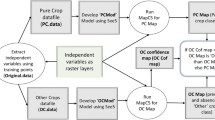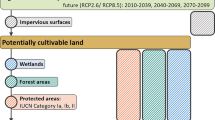Abstract
In most developing countries, people are heavily reliant on inexpensive, locally grown food. However, while dependence on cropping crosses national and continental boundaries, the selection of land for cropping has adapted to the available conditions. Recent analyses conducted by the Famine Early Warning System Network (FEWS NET) show that the characteristics of cropped area differ in different countries, indicating that the critical variables influencing the selection of location for the establishment of agriculture also vary. This study looks at a selection of FEWS NET work using high resolution remotely sensed imagery to analyze cropped areas in Afghanistan, Eritrea, Guatemala, Haiti, Mali, Mozambique, South Sudan, Burkina-Faso and Tajikistan. This analysis identifies similarities and differences in the significant factors impacting cropped area in each country. Furthermore, the effectiveness of the application of high-resolution imagery to estimating cultivation is assessed. The results highlight the context-specific nature of cultivation and the effectiveness of very high-resolution satellite imagery for crop estimation. The results also suggest that a single, generally applicable model of cultivation will require complex interactions between economic, governmental and population characteristics in addition to local landscape/geophysical properties.



Similar content being viewed by others
References
Bauer, M. E., Hixson, M. M., Davis, B. J., & Etheridge, J. B. (1978). Area estimation of crops by digital analysis of Landsat data. Photogrammetric Engineering and Remote Sensing, 44, 1033–1043.
Boudreau, T., Lawrence, M., Holzmann, P., O’Donnell, M., Adams, L., Holt, J., et al. (2008). The practitioners’ guide to the household economy approach. Johannesburg: Food Economy Group.
Brink, A., & Eva, H. (2009). Monitoring 25 years of land cover change dynamics in Africa: a sample based remote sensing approach. Applied Geography, 29, 501–512.
Diaz-Bonilla, E., M. Thomas, S. Robinson, and A. Cattaneo, 2000. Food security and trade negotiations in the world trade organization, international food policy research institute (IFPRI).
Fang, H. L. (1998). Rice crop area estimation of an administrative division in China using remote sensing data. International Journal of Remote Sensing, 19, 3411–3419.
Food and Agriculture Organization of the United Nations (1998). Multiple frame agricultural surveys: agricultural survey programmes based on area frame or dual frame (area and list) sample designs. Volume 10 of FAO Statistical Development Series: Food and Agriculture Organizations. Volume 2 of Multiple Frame Agricultural Surveys (p. 274). Rome: Food and Agriculture Organization of the United Nations.
Food and Agriculture Organization of the United Nations (2012). The State of food insecurity in the world 2012 : Economic growth is necessary but not sufficient to accelerate reduction of hunger and malnutrition (63 p). Food and Agriculture Organization of the United Nations: Rome.
Food and Agriculture Organization of the United Nations (2015). The state of food insecurity in the world 2015 meeting the 2015 international hunger targets: taking stock of uneven progress. Rome, Italy: FAO.
Funk, C., G. J. Husak, J. Michaelsen, T. Love, and D. Pedreros, 2007. Third generation rainfall climatologies: satellite rainfall and topography provide a basis for smart interpolation: crop and rangeland monitoring workshop.
Gallego, F. J. (2004). Remote sensing and land cover area estimation. International Journal of Remote Sensing, 25, 3019–3047.
Gallego, F. J., & Rueda, C. (1993). Balanced a priori probabilities for maximum likelihood classification of satellite images. Bulletin of the ISI, p. 467–468.
Gorte, B., & Stein, A. (1998). Bayesian classification and class area estimation of satellite images using stratification. IEEE Transactions on Geoscience and Remote Sensing, 36, 803–812.
Grace, K., Husak, G., Harrison, L., Pedreros, D., & Michaelsen, J. (2012). Using high resolution satellite imagery to estimate cropped area in Guatemala and Haiti. Applied Geography, 32, 433–440.
Grace, K., Husak, G., & Bogle, S. (2014). Estimating agricultural production in marginal and food insecure areas in Kenya using very high resolution remotely sensed imagery. Applied Geography, 55, 257–265.
Hammond, A. L. (1975). CROP FORECASTING FROM SPACE - TOWARD a GLOBAL FOOD WATCH. Science, 188, 434–436.
Hansen, M. C., Stehman, S. V., Potapov, P. V., Loveland, T. R., Townshend, J. R. G., DeFries, R. S., et al. (2008). Humid tropical forest clearing from 2000 to 2005 quantified by using multitemporal and multiresolution remotely sensed data. Proceedings of the National Academy of Sciences, 105(p), 9439–9444.
Hastie, T. J., & Tibshirani, R. J. (1990). Generalized additive models, Vol 43. CRC Press.
Hixson, M. M., Davis, B. J., & Bauer, M. E. (1981). Sampling Landsat classifications for crop area estimation. Photogrammetric Engineering and Remote Sensing, 47, 1343–1348.
Husak, G. J., Marshall, M. T., Michaelsen, J., Pedreros, D., Funk, C., & Galu, G. (2008). Crop area estimation using high and medium resolution satellite imagery in areas with complex topography. Journal of Geophysical Research: Atmospheres, 113, D14112.
Latham, J. S., He, C., Alinovi, L., DiGregorio, A., & Kalensky, Z. (2002). FAO methodologies for land cover classification and mapping. In Linking People, Place, and Policy (p. 283–316). US: Springer
Lelong, C. C. D., Pinet, P. C., & Poilvé, H. (1998). Hyperspectral imaging and stress mapping in agriculture: a case study on wheat in beauce (France). Remote Sensing of Environment, 66, 179–191.
Macdonald, R. B., & Hall, F. G. (1980). Global crop forecasting. Science, 208, 670–679.
Marshall, M., Husak, G., Michaelsen, J., Funk, C., Pedreros, D., & Adoum, A. (2011). Testing a high-resolution satellite interpretation technique for crop area monitoring in developing countries. International Journal of Remote Sensing, 32, 7997–8012.
Pittman, K., Hansen, M., Becker-Reshef, I., Potapov, P., & Justice, C. (2010). Estimating global cropland extent with multi-year MODIS data. Remote Sensing, 2, 1844–1863.
Pradhan, S. (2001). Crop area estimation using GIS, remote sensing and area frame sampling. International Journal of Applied Earth Observation and Geoinformation, 3, 86–92.
Senay, G. B., Budde, M., Verdin, J. P., & Melesse, A. M. (2007). A coupled remote sensing and simplified surface energy balance approach to estimate actual evapotranspiration from irrigated fields. Sensors, 7, 979–1000.
Smith, L. C., El Obeid, A. E., & Jensen, H. H. (2000). The geography and causes of food insecurity in developing countries. Agricultural Economics, 22, 199–215.
United States Agency for International Development, 2009. Application of the Livelihood Zone Maps and Profiles for Food Security Analysis and Early Warning: Guidance for Famine Early Warning Systems Network (FEWSNET) Representatives and Partners
Verdin, K., and S. Greenlee, 1998. HYDRO1k documentation: Sioux Falls, ND, US Geological Survey, EROS Data Center, http://edcdaac.usgs.gov/gtopo30/hydro/readme.html.
Vintrou, E., M. Houles, D. Seen, C. Feau, G. Laine, and A. Begue, 2009. Mapping cultivated area in West Africa using MODIS imagery and agroecological stratification. Geoscience and Remote Sensing Symposium, IEEE International, IGARSS p. V-393 - V-V-396.
Vintrou, E., Desbrosse, A., Begue, A., Traore, S., Baron, C., & Lo Seen, D. (2012). Crop area mapping in west Africa using landscape stratification of MODIS time series and comparison with existing global land products. International Journal of Applied Earth Observation and Geoinformation, 14, 83–93.
Wood, S. (2006). Generalized additive models: an introduction with R. CRC Press.
Xie, P., & Arkin, P. A. (1997). Global precipitation: a 17-year monthly analysis based on gauge observations, satellite estimates, and numerical model outputs. Bulletin of the American Meteorological Society, 78(11), 2539–92558.
Author information
Authors and Affiliations
Corresponding author
Rights and permissions
About this article
Cite this article
Husak, G., Grace, K. In search of a global model of cultivation: using remote sensing to examine the characteristics and constraints of agricultural production in the developing world. Food Sec. 8, 167–177 (2016). https://doi.org/10.1007/s12571-015-0538-6
Received:
Accepted:
Published:
Issue Date:
DOI: https://doi.org/10.1007/s12571-015-0538-6




